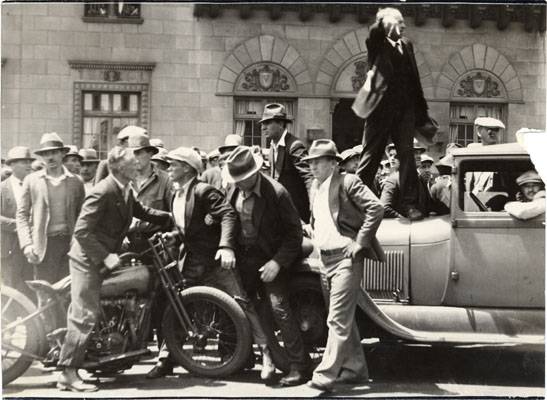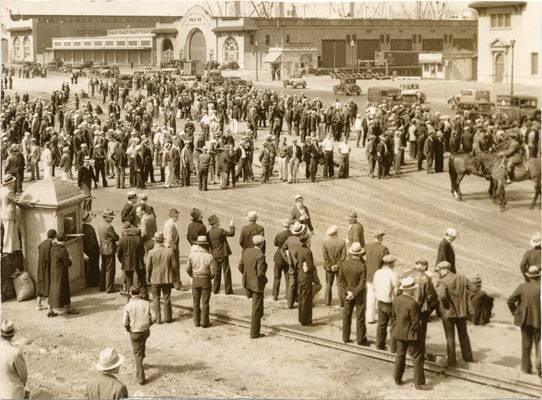The Waterfront Strike: Difference between revisions
(added new photo) |
(added new photo) |
||
| Line 17: | Line 17: | ||
[[Image:34strike$early-strike-march-34.jpg]] | [[Image:34strike$early-strike-march-34.jpg]] | ||
'''Waterfront Strike in | '''Waterfront Strike in May 1934, a part of the events leading up to the General Strike in July.''' | ||
''Photo: San Francisco History Center, San Francisco Public Library, San Francisco, CA'' | ''Photo: San Francisco History Center, San Francisco Public Library, San Francisco, CA'' | ||
Revision as of 22:03, 30 March 2013
Historical Essay
by Chris Carlsson
Waterfront strike, May 19, 1934.
Photo: San Francisco History Center, San Francisco Public Library, San Francisco, CA
{{#ev:archive|ssfGSTKSLNT|480}}
Video: Prelinger Archive
Waterfront Strike in May 1934, a part of the events leading up to the General Strike in July.
Photo: San Francisco History Center, San Francisco Public Library, San Francisco, CA
The new union militants held a convention in San Francisco in February 1934 for all the ILA longshoremen along the west coast. The workers met for ten days but excluded paid union officials as delegates. While they elected old officials to coordinate the West Coast organizing campaign, they also resolved that no agreement could be valid unless approved by a rank-and-file vote. They also put forth five demands: companies' full recognition of the union, union-controlled hiring halls to replace the shape-up, a raise in pay from $.85 to $1.30/hr., a 30-hour week, and a coast-wide agreement covering all US ports and expiring at the same time.
They also passed three important resolutions which strengthened their new power and self-confidence: a call for a waterfront confederation of all marine workers, including teamsters; rank-and-file gang committees to handle grievances instead of business agents; and opposition to arbitration since it always led to defeat.
The employers refused to deal with the convention and its demands on the grounds that it was communist-dominated. They assumed that the conservative leaders of the ILA, local leader William Lewis and national ILA president Joseph Ryan, would conclude favorable agreements preserving their accustomed power and profits, but they were in for a shock.
The longshoremen set a strike date of March 23 and elected a 25-man committee to organize it. The day before the scheduled walkout, President Roosevelt sent a telegram asking that it be postponed so that a fact-finding commission might conduct an investigation. A communist longshoreman, Sam Darcy, suggested that the delay was actually to ensure "a plentiful supply of student scabs" when the college semester ended later. ILA leader Lewis accepted the president's request anyway and after six weeks of secret negotiations concluded another unfavorable agreement.
The stevedores rejected it again and unanimously set a new strike date of May 9. Despite urgent appeals from ILA president Ryan and the federal government, the strike began on schedule and within a couple of days seamen were streaming off ships on their own strike and all the ports along the west coast were shut down. San Francisco Teamsters overruled their local president and refused to move cargo to or from the struck port.
Strikers face off against police on July 3, 1934 near Pier 28 on the southern waterfront.
Photo: San Francisco History Center, San Francisco Public Library



